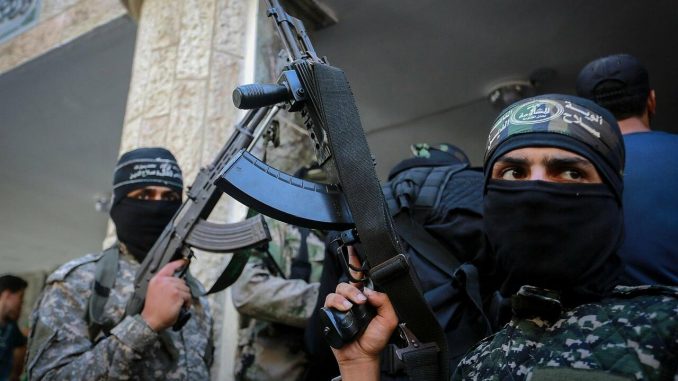
| Published July 5, 2025
Khalas and Khanidak clan fighters coordinate with IDF in Gaza as Israel exploits factional rifts to counter Hamas amid ongoing ceasefire deal talks
In a bold shift in strategy amid the ongoing war in Gaza, Israel is reportedly arming and supporting newly formed Palestinian militias inside the Strip to combat Hamas from within. This emerging effort—largely centered around Fatah-affiliated groups and powerful local clans—marks a significant escalation in Israel’s attempt to fragment Hamas’s grip on Gaza by leveraging internal Palestinian rivalries.
The development, first reported by Ynet and amplified by ZeroHedge and The Cradle, involves Israeli coordination with fighters in Gaza City, Khan Younis, and Rafah. These militias, some of which were previously dormant or marginal actors, are now being equipped, funded, and guided—indirectly or directly—by Israeli forces, raising serious questions about the future of Gaza’s internal governance, aid distribution, and the regional power balance.
While Israel has long sought alternatives to reoccupying Gaza, this new tactic signals a deeper investment in engineering internal opposition to Hamas. It also points to a murky new phase of the war: one fought not only by drones and tanks but by proxy fighters on the ground who may reshape the political and humanitarian landscape of postwar Gaza.
BACKGROUND
The current military campaign began after the October 7, 2023 Hamas attacks, which killed over 1,200 people in Israel. In response, the Israeli government launched a sustained offensive aimed at dismantling Hamas’s military infrastructure. However, the cost of house-to-house fighting, widespread international criticism, and mounting Israeli troop casualties forced decision-makers in Jerusalem to rethink their approach.
Rather than relying solely on direct occupation or waiting for a viable political alternative to Hamas to emerge organically, Israel began quietly fostering localized forces within Gaza. This strategy taps into the deep-rooted internal tensions between Hamas and rival factions like Fatah, as well as tribal and clan structures that have long played influential roles in Gazan society.
Two such groups—a Fatah-linked militia in Gaza City led by Rami Khalas, and another in Khan Younis led by Yasser Khanidak—have reportedly begun coordinating with the Israel Defense Forces (IDF). They receive arms, financial compensation, and strategic support, with salaries being paid through the Palestinian Authority (PA)—the same governing body ousted from Gaza by Hamas in 2007.
Another prominent group, the Popular Forces, emerged from the Abu Shabab clan in Rafah. Once seen as neutral or even sympathetic to Hamas, this group has now realigned, receiving Israeli-supplied Kalashnikovs and taking control of key aid convoys, according to sources.
For Israel, these partnerships offer a low-cost, low-footprint method of weakening Hamas’s stranglehold on Gaza. But for critics, it represents a dangerous gamble—one that could empower warlords, entrench lawlessness, and further fragment a traumatized population.
🔹 Broader Context: Clan-Based Militias & Aid Control
-
This is part of a broader Israeli approach to exploit rivalries within Gaza—arming and supporting local clans turned militias to counterbalance Hamas’s authority .
-
Independent reports, such as from AP and FDD, highlight a militia called the Popular Forces led by Yasser Abu Shabab in Rafah. The group has openly received Israeli weaponry (like Kalashnikovs) and is described by officials as responsible for protecting—and in some cases looting—aid convoys
-
UN officials have criticized the arrangement, warning that Israeli oversight—or lack thereof—over these armed groups may enable aid looting under the guise of security
🔹 Political & Security Risks
-
Israeli PM Netanyahu has publicly acknowledged that these measures aim to reduce IDF casualties by “activating clans in Gaza that oppose Hamas”
-
However, critics—including Israeli opposition figures (such as Avigdor Lieberman) and UN humanitarian officials—warn this strategy could inadvertently empower criminal or extremist gangs, undermine governance, and worsen the humanitarian crisis
-
There are also deep internal concerns: the Popular Forces, and leaders like Abu Shabab, are accused of criminality and even ties to extremist groups—claims they deny. Hamas has labeled them traitors and is targeting them
 Implications
Implications
🔹 Tactical Shift
Israel’s aim is to reduce IDF casualties by outsourcing localized enforcement to armed Gazan factions that share a common enemy in Hamas. According to Israeli officials, this helps “activate” internal opposition without full military occupation.
🔹 Aid Distribution & Lawlessness
While these groups provide some local security, they’ve also been accused of looting humanitarian aid, intimidating civilians, and acting more like criminal gangs than freedom fighters. The Popular Forces, for instance, have seized control of several aid convoys. UN officials warn this could worsen the humanitarian crisis and reduce trust in aid delivery systems.
🔹 Political Engineering
The Israeli government appears to be engineering a post-Hamas order by empowering rival forces that could serve as a buffer or even a future local authority—though critics say it risks turning Gaza into a patchwork of warlord-controlled zones.
CONTROVERSIES
-
Humanitarian concerns: Aid workers report increased attacks and chaos as armed groups assert control.
-
Internal Palestinian conflict: Hamas has labeled these militias as traitors, launching targeted strikes against them.
-
International backlash: Critics say Israel is fostering lawlessness and could face long-term blowback if these groups become uncontrollable or violate international law.
Even Israeli opposition figures have voiced concern, arguing that arming non-state actors undermines Israel’s moral standing and may backfire strategically.
 Overall Takeaway:
Overall Takeaway:
From a security-first viewpoint, Israel’s decision to arm anti-Hamas militias inside Gaza reflects a pragmatic, battlefield-driven strategy to dismantle terrorist infrastructure without permanent occupation. By leveraging internal divisions and supporting those willing to resist Hamas, Israel is attempting to lay the groundwork for a post-Hamas Gaza—one potentially led by factions more amenable to cooperation and stability.
However, whether this calculated gamble can avoid spiraling into unchecked factional violence remains uncertain.





Be the first to comment